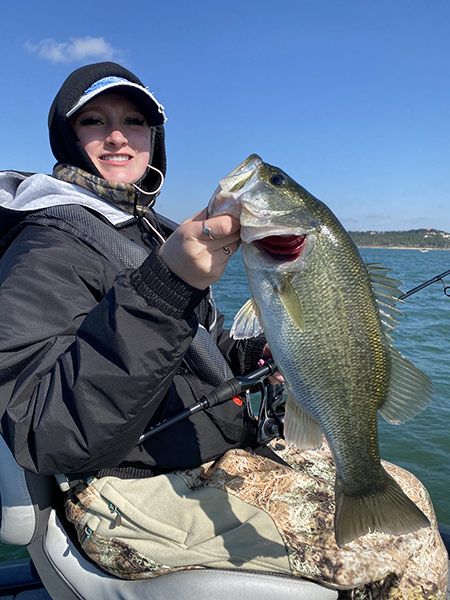
Avery Walker with a nice largemouth bass she caught one January on Canyon Lake, seen behind her. Due to the current drought, there is no inflow from the upper Guadalupe River, causing a thirty percent shrinkage in the lake. Fall fishing should provide unforgettable catches, however. (Photo by Phillip Walker)
by John Jefferson
I’ve been so concerned with the three dams under repair on the Guadalupe that I haven’t given much thought to the upper Guadalupe River and Canyon Lake. And that’s a mistake.
Canyon Dam forms Canyon Lake and is much younger than the four dams below it, which recently became the major news of the day.
But those lower lakes, Dunlap, McQueeny, Placid, and Wood (near Gonzales) get their water from the upper Guadalupe — and that’s often the first stream in Texas to fall into drought trouble.
In the late 60s and early 70s, I ran in a circle of wannabee adventurers that canoed the streams in Central Texas and made a few trips to the Big River – the Rio Grande. One day, I ran into one and asked when the next canoe trip was planned. He shook his head and replied, “Whenever it rains enough on the upper Guadalupe to float a canoe!”
I had overlooked the fact that Texas was in another drought – like the one we’re in. Most of the streams would have had trouble floating a dried elm leaf very far. And that’s about what it’s like, now.
A photo of Canyon Lake in the excellent regional publication, the “San Antonio Report,” shows an island in the middle of the lake. I can’t recall that ever happening. The Report says Canyon is at an all-time low, and only 70 percent full. Only three boat ramps remain open. And the Guadalupe River is providing no inflow, according to the Report quoting Robert Mace, Executive Director of the Meadows Center for Water at Texas State University.
Below Canyon Dam, the outflow from the lake, the Report says in the article by Lindsey Carnett, is enough to be “safe for recreational activities downriver.” That outflow is what’s slowly refilling Lake Dunlap.
I contacted Phillip Walker, my longtime fishing buddy, and a resident-angler on Canyon. Walker says that near the mouths of Comal Creek and Tom Creek, there is exposed land and “a hump of an island.” He also confirms the lack of inflow, having seen mere “puddles” in the riverbed.
When a lake recedes, dangers occur from rocks just under the surface that weren’t visible when the lake was full. Walker says it’s not unsafe now since the islands are exposed. This probably sounds familiar to readers of this column who follow the rise and fall of Lake Travis on the Colorado River north of Austin. To paraphrase and borrow a saying from Willie, “Go easy on the ‘throttle’ and enjoy the ride!” Avoiding rocks and old underwater trees is easier at slow speeds.
As for fishing, Phillip says Canyon Lake fish populations are at an all-time high. Cooler weather should create unforgettable catches. Ninety percent of the fish are said to be in ten percent of the water; they’re easier to find, now.
Look for largemouths in the upper third near the hydrilla. Smallmouths will be in the lower third near the shore.
Now’s the time!
JJ




